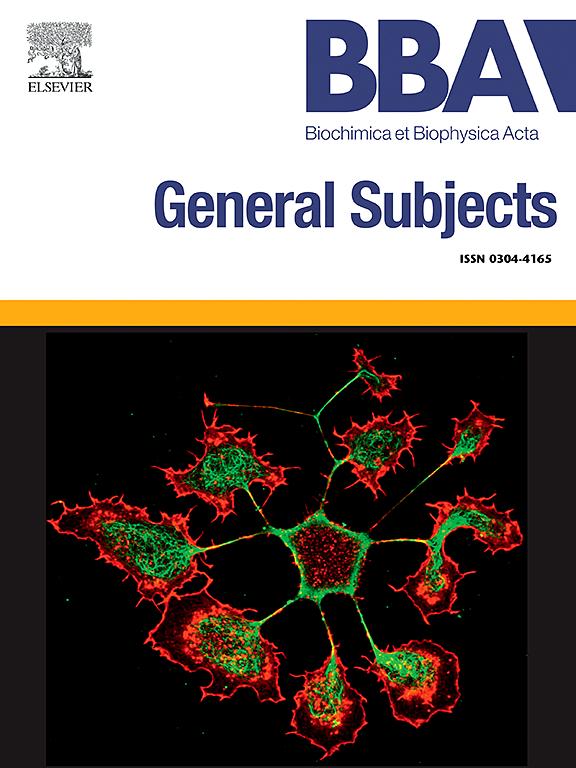Quantifying redox signalling regulatory transcriptional dynamics in Nardostachys jatamansi under abiotic stress response
IF 2.2
3区 生物学
Q3 BIOCHEMISTRY & MOLECULAR BIOLOGY
Biochimica et biophysica acta. General subjects
Pub Date : 2025-03-05
DOI:10.1016/j.bbagen.2025.130788
引用次数: 0
Abstract
Understanding the responses of Himalayan medicinal plants to multifactorial stresses is crucial in the face of increasing environmental challenges, primarily characterised by frequent temperature and water availability fluctuations. The present study investigates the physiological, biochemical, and transcript variations in the critically endangered Himalayan medicinal plant Nardostachys jatamansi subjected to cold (15 °C and 10 °C for 30 days), drought (6 % PEG for 30 days), and heat stress (30 °C for 24 h). The primary impact of stress was observed through reduced plant biomass and chlorophyll fluorescence. The effects of abiotic stresses were also evident in the modulation of electrolyte leakage, MDA content and H2O2 accumulation. Accumulation of reactive oxygen species was confirmed through DAB and NBT staining, alongside increased DPPH and ABTS radical scavenging activity. Differential expression profiling of the RBOH family transcripts further substantiated the production of ROS. Enhanced enzymatic and non-enzymatic activities were observed under each abiotic stress condition. Additionally, genes specific to the regulatory mevalonate (MVA) pathway (TPS9; HMGR) and the methylerythritol phosphate (MEP) pathway (DXS1; DXR) were found to be differentially regulated. Moreover, differential expression profiling of abiotic stress signalling regulatory transcripts CRLK1, CRLK2, CaM6 and ICE1 was also discovered. These findings provide valuable insights into the physiological and biochemical profiling of N. jatamansi in response to extreme environmental conditions, significantly aiding our understanding of the adaptation strategies of alpine vegetation for their conservation.

非生物胁迫下野竹氧化还原信号调控转录动力学的定量研究
面对日益严峻的环境挑战,了解喜马拉雅药用植物对多因素胁迫的反应是至关重要的,主要特征是温度和水分的频繁波动。本研究研究了喜马拉雅濒危药用植物Nardostachys jatamansi在低温(15°C和10°C处理30 d)、干旱(6% PEG处理30 d)和热胁迫(30°C处理24 h)下的生理生化和转录本变化。胁迫的主要影响是通过降低植物生物量和叶绿素荧光来观察。非生物胁迫对电解质泄漏、MDA含量和H2O2积累的影响也很明显。通过DAB和NBT染色证实了活性氧的积累,同时增加了DPPH和ABTS自由基清除活性。RBOH家族转录本的差异表达谱进一步证实了ROS的产生。在各种非生物胁迫条件下,酶和非酶活性均有所增强。此外,调节甲羟戊酸(MVA)途径的特异性基因(TPS9;HMGR)和甲基赤四醇磷酸(MEP)途径(DXS1;DXR)被发现有差异调控。此外,我们还发现了非生物胁迫信号调控转录物CRLK1、CRLK2、CaM6和ICE1的差异表达谱。这些发现为深入了解贾塔曼尼对极端环境条件的生理生化特征提供了有价值的见解,对我们了解高山植被保护的适应策略具有重要意义。
本文章由计算机程序翻译,如有差异,请以英文原文为准。
求助全文
约1分钟内获得全文
求助全文
来源期刊

Biochimica et biophysica acta. General subjects
生物-生化与分子生物学
CiteScore
6.40
自引率
0.00%
发文量
139
审稿时长
30 days
期刊介绍:
BBA General Subjects accepts for submission either original, hypothesis-driven studies or reviews covering subjects in biochemistry and biophysics that are considered to have general interest for a wide audience. Manuscripts with interdisciplinary approaches are especially encouraged.
 求助内容:
求助内容: 应助结果提醒方式:
应助结果提醒方式:


